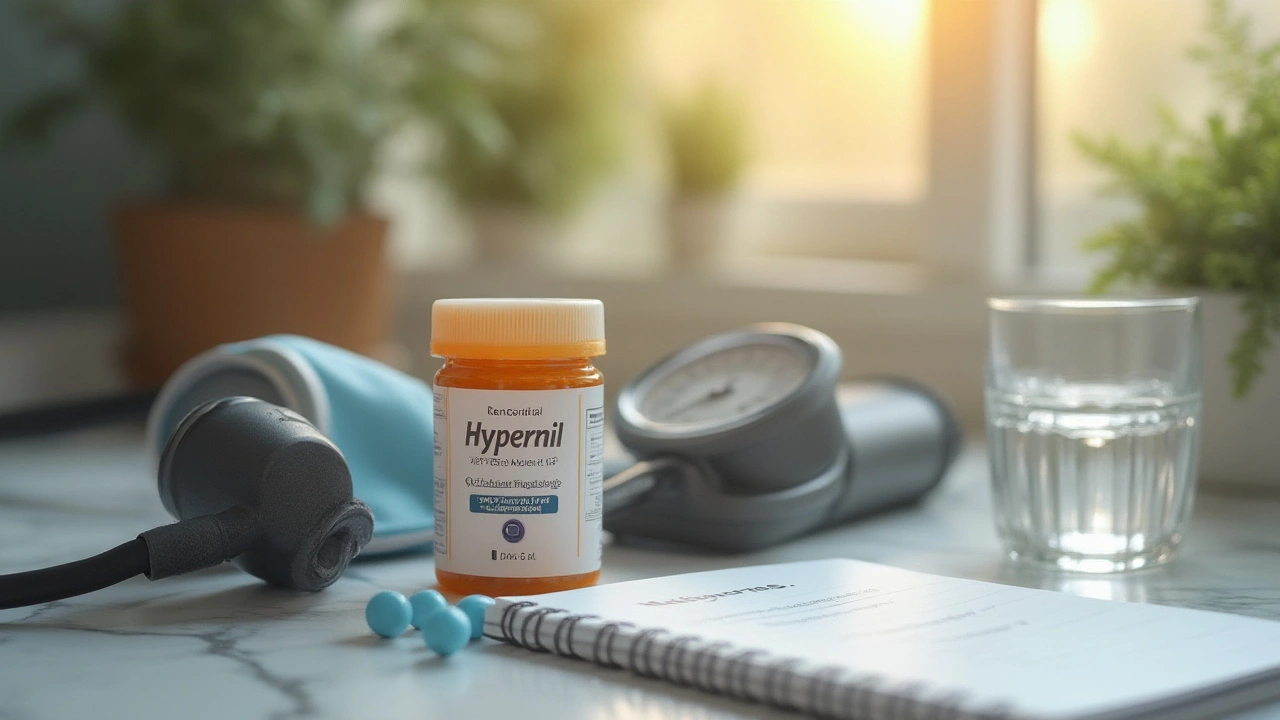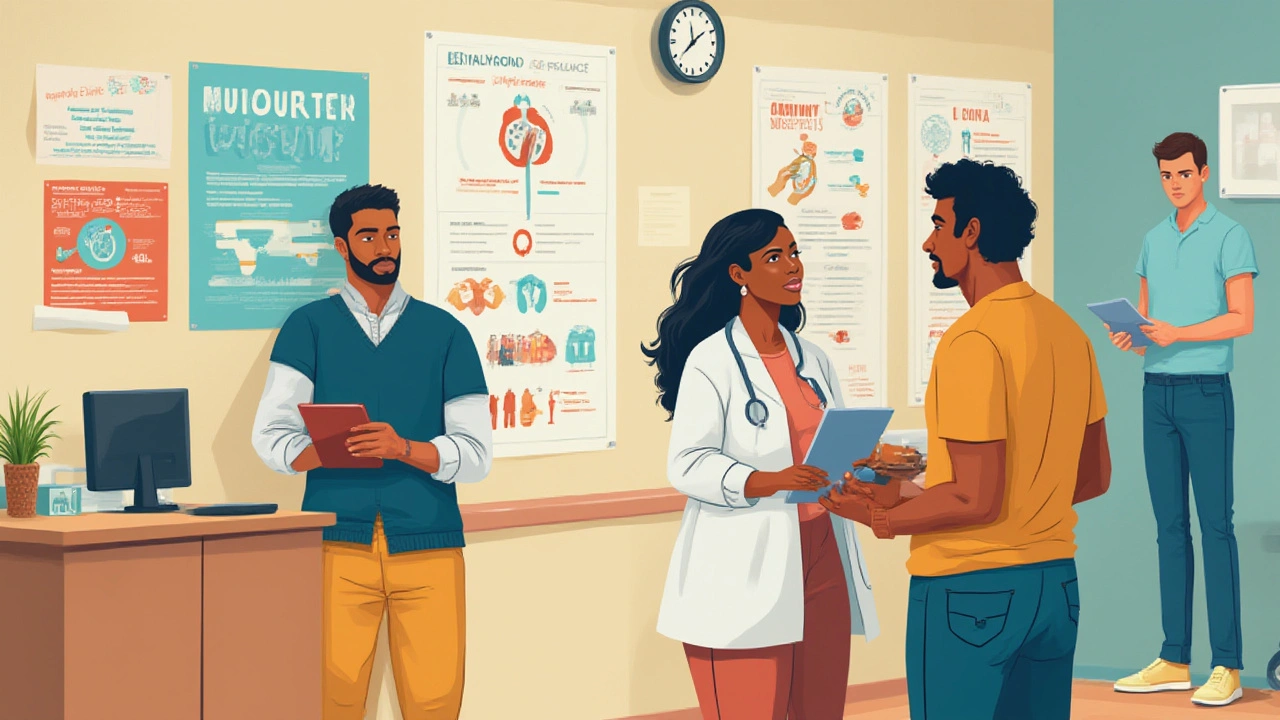Hypernil: Understanding Its Uses, Benefits, and Effects

Imagine popping a small pill every morning and suddenly, the numbers on your blood pressure monitor behave. That’s kind of the magic folks hope for with Hypernil, a name you’ve probably heard tossed around in doctor’s offices or scribbled on prescription pads. But what’s actually in that little tablet, and why do doctors trust it enough to hand it out so much? Standing in the pharmacy line with a Hypernil script, you might be tempted to Google everything you can. Good. You should. It’s a medication with real power, both to help and to bring a few surprises you’d be smart to know about.
What is Hypernil and How Does it Work?
So, Hypernil—what’s the story here? Hypernil is a prescription medication often used for managing high blood pressure, also known as hypertension. Inside the capsule, you’ll usually find an active ingredient like amlodipine, a calcium channel blocker that helps your blood vessels relax and widen, making it easier for your heart to pump and blood to flow smoothly.
The real kicker is how it tackles blood pressure at its roots. Every time your heart pumps, blood surges through tubes (aka arteries) that can narrow over time. Hypernil’s job is to ease up the tension on those vessels by blocking certain signals to your vessel walls, acting kind of like turning down the volume on a too-loud radio. When your arteries can chill out, your blood pressure drops—sometimes going from dangerous territory to a much safer zone. This reduces the risk of some scary things: stroke, heart attack, and kidney problems, to name a few.
Let’s get into a real-world stat. According to a global study, calcium channel blockers cut the risk of cardiovascular events by over 20% in people with hypertension. In plain English? If your blood pressure is up, a med like Hypernil can seriously boost your odds of dodging heart trouble.
But Hypernil isn’t just for high blood pressure. Sometimes, it’s used in folks with angina (that’s chest pain from strained heart muscles), or, less commonly, as a backup in heart failure cases when other drugs can’t do the trick. Its versatility is one big reason why you see it prescribed across all age groups, from younger adults with hereditary hypertension to seniors managing complicated health profiles.
One important thing: Hypernil isn’t a quick fix. It takes consistent daily use for weeks before the full effect settles in. Some people notice results sooner, but skipping doses or stopping suddenly is like letting go of the leash on a wild dog—things get unpredictable fast.
Benefits of Hypernil: Why Do Doctors Prescribe It?
If you want to see why Hypernil is practically a household name in hypertension care, you have to peek at its benefits. First and most obvious, it lowers high blood pressure where other methods (like diet and exercise) might fall short or take too long to work. For many people, combining Hypernil with healthier habits makes the improvements stick, but even alone, the pill can bring numbers down remarkably well.
But the benefits don’t stop at numbers on a screen. When blood pressure is controlled long-term:
- The heart doesn’t have to fight so hard, reducing wear and tear that can lead to heart failure.
- The risk of blood vessels bursting (think brain bleeds or aneurysms) drops by up to 60% according to the European Society of Cardiology.
- Kidney health gets a boost, too. Uncontrolled hypertension is a straight shot to chronic kidney disease, but lowering pressure protects those tiny filtering units in your kidneys.
- Eyes stay healthier. High blood pressure can mess with tiny blood vessels behind your eyeballs, but Hypernil helps prevent vision loss linked to hypertension.
Another thing in Hypernil’s favor: It’s well-tolerated. Patients report fewer serious side effects compared to several other blood pressure drugs. That means doctors don’t have to play musical chairs trying to find a working, tolerable dose. For a lot of people, Hypernil is a “set and forget” prescription—come back every few months for a checkup, and just keep counting out the pills before breakfast each day.
Here’s a handy breakdown showing how Hypernil stacks up against other blood pressure meds when it comes to reducing key risks:
| Medication | Reduced Stroke Risk | Kidney Protection | Common Side Effects |
|---|---|---|---|
| Hypernil (Amlodipine) | 19-24% | Yes | Swelling in ankles |
| ACE Inhibitors | 18-25% | Yes | Cough |
| Beta Blockers | 10-15% | No | Fatigue, cold hands |
From a doctor’s perspective, Hypernil’s track record for long-term cardiovascular protection is hard to beat. It works especially well when paired with drugs from other classes, targeting multiple parts of the blood-pressure equation and covering patients who don’t respond to one med alone.

Side Effects and What to Watch For
No treatment’s perfect—Hypernil proves that, too. The most common thing people notice is swelling in the lower legs and ankles (doctors call this "peripheral edema"). It’s annoying but usually harmless. The odd tingly feeling in the legs, a bit of flushing, or mild dizziness can also happen, especially right when you start out or after upping the dose.
Now, once in a while, people run into slower heart rates or a drop in blood pressure that leaves them lightheaded. If that shows up, your doctor might tweak your dose or suggest you stand up a bit more slowly in the mornings.
There are also rare but real risks—rashes, severe chest pain, or allergic reactions need quick attention. Let your doctor know right away if anything feels "off.” There have even been documented cases in medical journals of Hypernil triggering gum swelling (“gingival overgrowth”), but this usually resolves after switching meds or lowering the dose—and good dental care helps, too.
Medications like Hypernil don’t mix well with certain other pills. For example, grapefruit juice can mess with how your body handles the drug, causing higher levels in your blood than intended. Antibiotics like clarithromycin and antifungal drugs like itraconazole can also crank up side effects. Always double-check any new med (even over-the-counters!) with your pharmacist.
- Stay hydrated. Swelling gets worse if you’re dehydrated.
- Monitor blood pressure at the same time each day, using the same arm—consistency matters.
- If you miss a dose, take it as soon as you remember—unless it’s almost time for your next one. Doubling up is a bad plan.
Most people who run into problems do well with a simple tweak to their routine or dose. Don’t ever stop this (or any blood pressure med) without talking to your doctor. Sudden changes can put your body under dangerous stress.
Practical Tips for Living Well with Hypernil
Taking medication every day doesn’t have to feel like a life sentence. With Hypernil, building a routine makes things pretty close to painless. Set a phone alarm, pair your pill with something you never forget—breakfast, brushing teeth, morning coffee. Consistency is the real hero here.
Blood pressure numbers will wander a bit, but trends matter more than single readings. Keep a notebook or use a tracking app. If you start seeing numbers creep up again, jot down recent changes—diet, stress, even sleep—all of this can matter. That way, you walk into your checkup with real info, not just a hunch.
Stay active, even if it’s just a daily walk. Research from the American Heart Association shows that low-impact exercise (like brisk walking, cycling, or swimming) helps blood pressure control almost as much as drugs do. And these activities are safe for most people on Hypernil, unless your doctor says otherwise.
Don’t forget about food. Too much salt can make Hypernil work overtime, so be careful with processed snacks and canned foods. Instead, boost potassium by eating bananas, oranges, spinach, and sweet potatoes, unless you’ve got a reason to avoid them (some kidney issues make high potassium risky—your doctor will flag this).
Stress is sneaky. Pick up tools that help you let off steam—a favorite hobby, meditation, or even just talking things out with a friend can lower numbers without a prescription. Some folks find that even a bit of deep breathing right before checks at the doctor’s office brings more accurate readings.
- Keep extra medication on hand, especially if you travel.
- Wear a medical alert bracelet if you’re taking several meds, so first responders know about Hypernil in emergencies.
- Bring your pill bottle to appointments so your medical team can review everything you’re taking.
Ask questions. If your doctor’s using words you don’t get, ask for plain English. Good care starts when you actually know what’s going into your body and why.

Looking Ahead: The Future of Hypertension Care with Hypernil
Blood pressure treatment is shifting fast. Hypernil is already a top pick for millions, but researchers are constantly searching for tweaks that work better, cause fewer side effects, or fit different lifestyles. In 2025, clinical trials are looking at combination pills—mixing Hypernil’s main ingredient with other drugs in a single dose, making routines even simpler.
Wearable technology is also changing the game. A watch that takes your blood pressure and syncs with your phone might soon send updates straight to your doctor’s office for more personalized care and faster tweaks to treatment if your numbers drift. This means adjustments to Hypernil and other meds might happen quicker and with less hassle, slashing your risk of long-term complications.
On the horizon, scientists are digging into personalized medicine—figuring out which people respond best to which meds based on their DNA. Hypernil works for most, but someday your prescription might come tailored for your genes, side-stepping risks before they start.
For now, if your doctor talks about Hypernil, you can feel pretty confident there’s solid science behind it. It’s stood the test of time, survived waves of new therapies, and still ranks high for doing one crucial job: keeping your heart and blood vessels safe. It isn’t flashy or exciting, but sometimes, what’s boring and reliable might just save your life.
Brandon Trevino
July 22, 2025 AT 12:49Denise Wiley
July 22, 2025 AT 20:20Hannah Magera
July 24, 2025 AT 11:06Austin Simko
July 25, 2025 AT 21:56Nicola Mari
July 27, 2025 AT 08:00Sam txf
July 28, 2025 AT 06:34Michael Segbawu
July 29, 2025 AT 18:30Aarti Ray
July 30, 2025 AT 05:18Alexander Rolsen
July 31, 2025 AT 13:07Leah Doyle
August 1, 2025 AT 21:34Alexis Mendoza
August 3, 2025 AT 08:00Michelle N Allen
August 4, 2025 AT 07:35Madison Malone
August 5, 2025 AT 00:42Graham Moyer-Stratton
August 5, 2025 AT 23:57tom charlton
August 6, 2025 AT 19:17Jacob Hepworth-wain
August 7, 2025 AT 11:28Craig Hartel
August 7, 2025 AT 22:03Chris Kahanic
August 8, 2025 AT 22:01